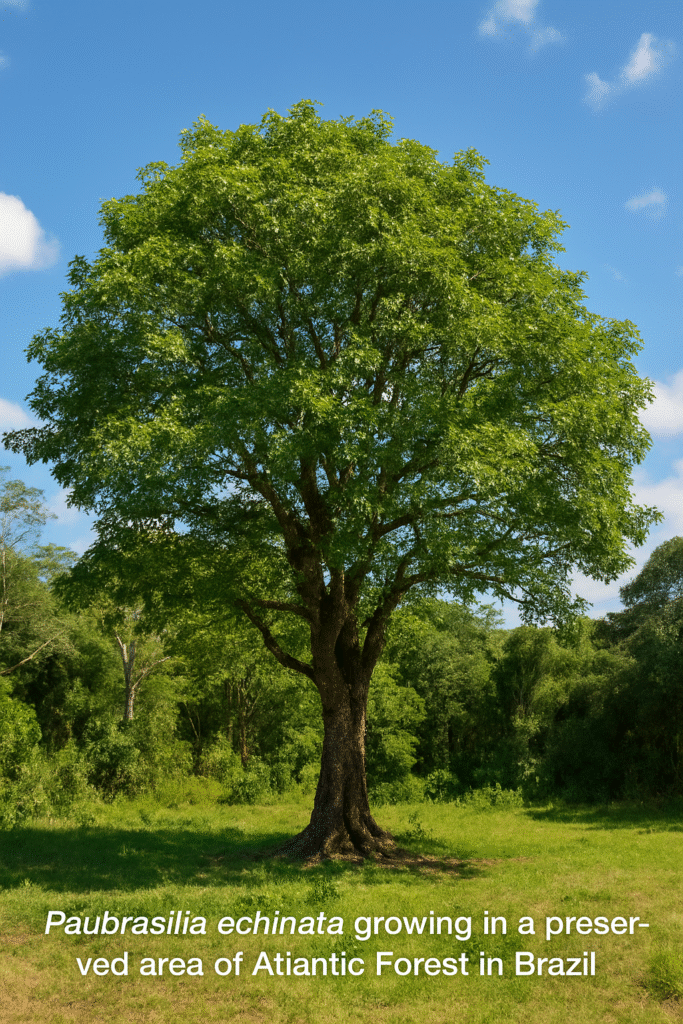Introduction
The Brazilwood (Paubrasilia echinata), also known as ibirapitanga by Indigenous peoples, is one of the most iconic trees of Brazilian flora. A national symbol, this species holds historical, cultural, and environmental significance. It was the first natural resource exploited by Portuguese colonizers and is the reason the country is called “Brazil.” In this article, we explore its botanical characteristics, historical importance, conservation status, and fascinating facts.
Botanical Characteristics
Brazilwood belongs to the Fabaceae family, subfamily Caesalpinioideae. It is a medium-sized leguminous tree that can reach between 10 and 15 meters (33–49 feet) in height under ideal conditions. It has a straight trunk with a thick, gray bark, often covered in thorns. The leaves are compound with small, symmetrical leaflets.
It typically flowers between September and October, producing yellow to orange blossoms that attract pollinators. The fruits are seed pods that open naturally when ripe, releasing viable seeds.
The tree’s most distinctive feature lies in its heartwood, which has a deep reddish hue due to the presence of brazilin, a natural dye once widely used in Europe.
Historical and Economic Importance
During the colonial period, Brazilwood was the first major economic export of Portuguese Brazil. Between the 16th and 17th centuries, thousands of trees were felled to extract the valuable wood, which was shipped to Europe for furniture production and, most notably, for red dye used in luxury textiles.
It is estimated that millions of Brazilwood trees were cut along the Atlantic coast. This uncontrolled exploitation led to a dramatic population decline, pushing the species toward extinction.
Brazilwood wood was also prized in the making of violin bows, thanks to its density, elasticity, and excellent acoustic properties.
Distribution and Natural Habitat
Originally, Brazilwood was found throughout the Atlantic Forest, from Rio Grande do Norte to Rio de Janeiro. Today, its natural range is highly fragmented, limited to a few protected or reforested areas, mainly in Bahia, Pernambuco, Espírito Santo, and Rio de Janeiro.
It thrives in well-drained soils with moderate humidity and partial sunlight. In reforestation projects, it has shown resilience and adaptability, although its initial growth is relatively slow.
Conservation Status
Brazilwood is currently classified as endangered by the IUCN Red List. In Brazil, it has been legally protected since 1978, and cutting, transporting, or trading the wood requires special authorization from environmental agencies.
Several conservation projects have been implemented in recent decades, focusing on reforestation, seed banks, and genetic studies to preserve the species’ biodiversity.
Additionally, Brazilwood Day, celebrated on May 3rd, raises public awareness about its historical and ecological importance and the need to protect it for future generations.
Fascinating Facts About Brazilwood
- The name Brazil comes from “brasa” (ember), referring to the reddish color of its wood.
- In the 16th century, conflicts between Portuguese, French, and Dutch forces were partly fueled by competition over Brazilwood.
- It was declared the national tree of Brazil by law in 1978.
- Its flowers are also national symbols and appeared on older Brazilian currency.
- Despite historical overuse, its wood is still highly prized by artisans, especially in the making of professional violin bows.
Conclusion
More than just a tree, Brazilwood is a living piece of Brazil’s history and biodiversity. It is a powerful symbol of Atlantic Forest conservation and national identity. Protecting this species is essential not only for ecological balance but also to preserve a vital link to Brazil’s origins.

Discover Rare and Beautiful Succulents
Looking for unique, healthy, and eye-catching succulents? At Leaf & Clay, you’ll find exotic varieties perfect for any indoor garden or tropical plant collection.
Explore their curated selection and get inspired to grow something extraordinary today
Learn how Hevea brasiliensis revolutionized industries with its natural latex and continues to shape modern life.

